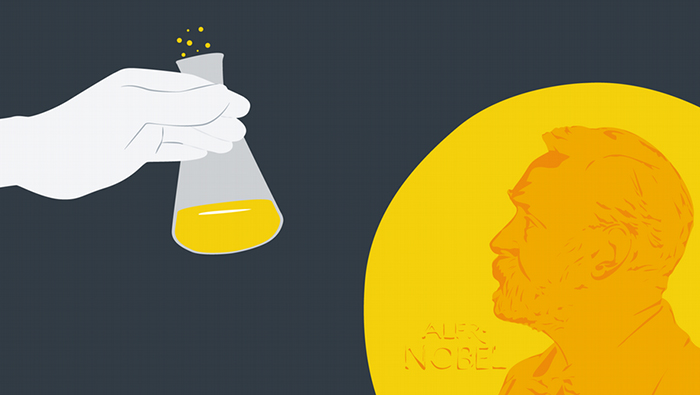
Stockholm: This year, the Nobel Prizes for science present an all-male line-up. Like the awards in Medicine and Physics earlier this week, the Nobel Prize in Chemistry was awarded to two male scientists.
Germany's Benjamin List and US-based chemist David MacMillan were awarded the Chemistry prize for their development of a precise new tool for molecular construction: organocatalysis.
While their tool might sound complicated, it's exactly the opposite: it makes the job of chemists easier, cheaper and greener.
Pernilla Wittung Stafshede of the Nobel Prize Committee called it "truly elegant."
What did they do?
Chemists build molecules, which then make up much of our surrounding world: they capture light in solar cells, form lightweight running shoes or inhibit the progression of disease in the body. Because of this, many of our industry and research areas depend on the ability of chemists to construct molecules.
But to construct molecules chemists need a catalyst — a tool for controlling and accelerating chemical reactions. Researchers long believed that there were just two catalysts: metals and enzymes. In 2000, that changed: List and MacMillan developed a third catalyst which builds on small organic molecules, called asymmetric organocatalysis. Their organic catalyst is both environmentally friendly and cheap to produce.
"This concept for catalysis is as simple as it is ingenious, and the fact is that many people have wondered why we didn't think of it earlier," said Johan Åqvist, chair of the Nobel Committee for Chemistry.
A booming breakthrough
While List and Macmillan discovered this new type of catalyst independently from one another, in a sense, they did it side-by-side: Coincidentally, they had the brilliant idea almost simultaneously in 2000, while working in the same corner of the world.
List was conducting research at the Scripps Research Institute in southern California and MacMillan was in Berkeley when their organocatalyst was born.
Since then, organic catalysts have transformed from a newcomer to a staple in chemists' tool boxes.
The Nobel Committee for Chemistry described the development of this type of catalyst as "a gold rush, in which List and Macmillan maintain leading positions."
Their rapid expansion in chemistry research is due to their ability to drive asymmetric catalysis. Oftentimes, when new molecules are being built, two molecules can form, which are mirror images of one another.
Chemists will often only need one of these molecules, particularly when producing pharmaceuticals. With organic catalysts, researchers can produce large volumes of different asymmetric molecules, instead of two of the same kind.
The Chemistry Prize
Chemistry was the most important science for Alfred Nobel — the originator of these prizes — and his achievements. That goes for the development of his own inventions as well as the processes he introduced into industrial production — it was all based on chemistry. As such, chemistry was the second area of fundamental research that Nobel mentioned in his testament and will.
In 2020, the Nobel Prize for Chemistry was awarded for a potentially revolutionary human gene editing technology known as CRISPR-Cas9.
Two scientists were recognised for their work in this area, one from France and the other from the USA: Emmanuelle Charpentier and Jennifer Doudna, respectively.
Together, it is said Doudna and Charpentier have revolutionised medicine and biotechnology. CRISPR-Cas9 makes it technically possible to develop therapies against hereditary diseases and the cultivation of plants resistant to disease.
The Committee said at the time that CRISPR-Cas9 had opened new possibilities for molecular life sciences, that the technology could help researchers develop innovations in cancer treatment and fulfil the dream of curing hereditary diseases.
It said Emmanuelle Charpentier and Jennifer Doudna had made one of the most powerful tools in gene technology a reality. The Committee said researchers would be able to modulate or modify the DNA of animals, plants and microorganisms with the height of precision.
A week of prizes
Chemistry is the third and final science award in this week of Nobel Prizes.
The week began with Physiology or Medicine on Monday. That was won by David Julius und Ardem Patapoutian for the discovery of human receptors for temperature and touch.
On Tuesday, one half of the Physics prize was awarded to climatologists and meteorologists Syukuro Manabe (Japan) and Klaus Hasselmann (Germany), and the other half went to Giorgio Parisi (Italy) for research on complex systems.
Later in the week, there will be Nobel Prizes for Literature, Peace, and then Economic Sciences.
120 years of prizes
The Nobel Prizes are in their 120th year. And over that time, it's nurtured a reputation as being both secretive and rigorous. It very often awards its accolades to more than one person but a maximum of three.
And while many scientists might quietly hope to get the recognition of a Nobel Prize one day, some say it's good enough to have one's work associated with a Nobel Prize and let other scientists be the "victims" who sacrifice themselves and "bear all the burden of media hype to be there for a good cause."
That was Karsten Danzmann's take when in 2017 the Physics Prize was awarded to the LIGO (Laser Interferometer Gravitational-Wave Observatory) for observing gravitational waves. Danzmann was involved in that work, as were about a thousand other scientists, but only three of them were named.
And the Committee is tough: If in any year it thinks no nominees are worth it, they reserve the right to let the prize money rollover into the next year.
This year's winners receive cash prize of 10 million Swedish Krona (about €980,000), a Nobel Medal and a range of other trinkets.
But they will have to wait until December 10, because tradition also has it that the prizes is handed out at a gala dinner in Stockholm.